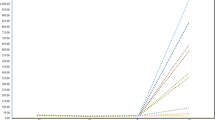Abstract
The six basic generations (two parents, \(\hbox {F}_{1}\), \(\hbox {F}_{2}\) and backcrosses) of 14 crosses developed from nine parents differing in fruits \(\hbox {node}^{-1}\) and fruit orientation were evaluated to decipher the genetics of three quantitative traits (average fruit weight, fruits \(\hbox {plant}^{-1}\) and green fruit yield \(\hbox {plant}^{-1})\) during the rainly season of 2016 and 2017. The magnitude and direction of the additive genetic effects [a], dominance genetic effects [d], magnitudes of additive genetic variance (\({\upsigma }_{\mathrm{A}}^2 )\) and dominance genetic variance (\({\upsigma }_{\mathrm{D}}^2 )\) varied with the genetic background of the crosses and traits. In the genetic background of crosses involving parents differing in fruit \(\hbox {node}^{-1}\), the inheritance of average fruit weight, fruits \(\hbox {plant}^{-1}\) and fruit yield \(\hbox {plant}^{-1}\) were controlled by the genes with both additive and ambidirectional dominant effects. On the contrary, genes with only additive effects controlled the inheritance of average fruit weight, fruits \(\hbox {plant}^{-1}\) and fruit yield \(\hbox {plant}^{-1}\) in most genetic backgrounds of crosses involving parents differing in fruit orientation and those differing in both fruits \(\hbox {node}^{-1}\) and fruit orientation. Further, the genes controlling the inheritance of all the traits are dispersed among the parents used in the investigation. These results are discussed in relation to strategies to be used in breeding chilli.
Similar content being viewed by others
References
Acquaah G. 2012 Principles of plant genetics and breeding, 2nd edition, pp. 63–75. Wiley, Hoboken.
Ahmed J., Shivhare U. S. and Raghavan G. S. V. 2000 Rheological characteristics and kinetics of color degradations of green chilli puree. J. Food Eng. 44, 239–244.
Anandhi K. and Abdul Khader K. M. 2011 Gene effects of fruit yield and leaf curl virus resistance in interspecific crosses of chilli (Capsicum annuum L. and Capsicum frutescens). J. Trop. Agric. 49, 107–109.
Anilkumar C., Mohan Rao A., Ramesh S., Bhavani B., Mangalagowri N. and Ashwini M. 2018 Yield stability of chilli (Capsicum annuum L.) hybrids differing for fruiting habit traits. Int. J. Curr. Microbiol. App. Sci. 7, 1664–1674.
Bento C. S., Rodrigues R., Sudre C. P., Medeiros A. M., Mathias V. A. S. and Goncalves L. S. A. 2016 Determining the inheritance of agronomic traits in chili pepper. Hortic. Bras. 34, 367–373.
Bernardo R. 1996 Best linear unbiased prediction of maize single cross performance. Crop Sci. 36, 50–56.
Bernardo R. 2010 Breeding for quantitative traits in plants, pp. 173–175. Stemma Press, Woodbury.
Bernardo R. 2014 Essentials of plant breeding, pp. 23–69. Stemma Press, Woodbury.
Cavalli I. L. 1952 Analysis of linkage in quantitative inheritance. In Quantitative inheritance (ed. E. C. R. Reeve and C. H. Waddington), pp.135–144. HMSO, London.
Chakrabarty S. and Aminul Islam A. K. M. 2017 Selection criteria for improving yield in chili (Capsicum annuum L.). Adv. Agric. 2017, 1–10.
Dasgupta and Reshmi R. 2011 Indian chilli displacing jalapenos in global cuisine – The Economic Times. The Times of India.
Dudley J. W. 1997 Quantitative genetics and plant breeding. Adv. Agron. 59, 1–23.
Fisher R. A. 1950 Contributions to mathematical statistics, pp. 390–398. Wiley, New York.
Geetha R. and Selvarni K. 2017 A study of chilli production and export from India. Int. J. Adv. Res. Inov. Ideas Edu. 3, 205–210.
Goodnight C. J. 1998 Epistasis and the effect of founder events on the additive genetic variance. Evolution 42, 441–454.
Hallauer A. R. and Miranda F. O. 1988 Quantitative genetics in maize breeding, 2nd edition, vol. 6, pp.119. Iowa State University Press, Ames.
Hallauer A. R. 1985 Compendium of recurrent selection methods and their application. Crit. Rev. Plant Sci. 3, 1–10.
Hanson W. D. 1959 The break-up of initial linkage blocks under selected mating system. Genetics 44, 857–868.
Jayasekara N. E. M. and Jinks J. L. 1976 Effect of gene dispersion on the estimates of components of generation means and variances. Heredity 36, 171–173.
Jinks J. L. 1981 The genetic framework of plant breeding. Philos. Trans. R. Soc. London Ser. B. 292, 407–414.
Kearsey M. J. and Pooni H. S. 1996 The genetic analysis of quantitative traits. Chapman and Hall, London.
Mather K. and Jinks J. L. 1982 Biometrical genetics, 3rd edition, pp. 396. Chapman and Hall, London.
Moll R. and Stubber C. W. 1974 Quantitative genetics – empirical results relevant to plant breeding. Adv. Agron. 26, 277–313.
Palmer T. P. 1953 Progressive improvement in self-fertilized crops. Heredity 7, 127–129.
Pawar S. S., Bharude N. V., Sonone S. S., Deshmukh R. S., Raut A. K. and Umarkar A. R. 2011 Chillies as food, spice and medicine: a perspective. Int. J. Pharm. Biol. Sci. 1, 311–318.
Perucka I. and Materska M. 2007 Antioxidant vitamin contents of Capsicum annuum fruit extract as affected by processing and varietal effects. Acta Sci. Pol. Technol. Aliment. 6, 67–74.
Rasmusson D. C. and Philip R. L. 1997 Plant breeding progress and genetic diversity from de novo variation and elevated epistasis. Crop Sci. 37, 303–310.
Saleh B. K., Omer A. and Teweldemedhin B. 2018 Medicinal uses and health benefits of chili pepper (Capsicum spp.): a review. MOJ Food Process Technol. 6, 325–328.
Salimath P. M. and Bahl P. N. 1985 Early generation selection in chickpea III. Predicted and realized gains. Exp. Genet. 1, 59–62.
Acknowledgements
Senior author gratefully acknowledge the financial support from University Grant Commission (UGC), New Delhi, India in the form of National Fellowship for students of other backward classes (NF-OBC) (F./201617/NFO201517OBCKAR47283/(SAIII/Website) for pursuing Ph.D. course.
Author information
Authors and Affiliations
Corresponding author
Additional information
Corresponding editor: H. A. Ranganath
AMR and SR, conceptualization of research; CA, AMR, SR and BB, designing experiments; AMR, contribution of experimental material; CA, BB and P, execution of field/lab experiments and data collection; CA, AMR and SR, analysis of data and interpretation; CA, SR, AMR and P, preparation of manuscript.
Rights and permissions
About this article
Cite this article
Anilkumar, C., Rao, A.M., Ramesh, S. et al. Genetics of fruit yield and its component traits under different fruiting habit backgrounds in chilli (Capsicum annuum L.). J Genet 98, 84 (2019). https://doi.org/10.1007/s12041-019-1133-y
Received:
Revised:
Accepted:
Published:
DOI: https://doi.org/10.1007/s12041-019-1133-y




